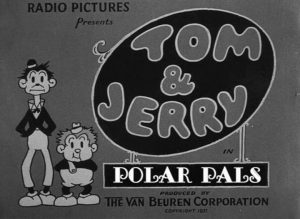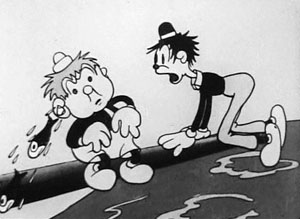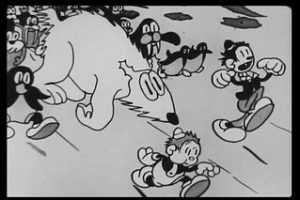
Spring and Summer and beautiful seasons. I’ve been trying to be outdoors as much as I can and sometimes have had to be as I’ve been spending some time walking around the Auto U-pull lot as well as working on putting pieces together on the front of a truck! Life is silly.
 This week, under a pretty moon shining into the basement, I was busy making up reels of cartoons to take to scan. Since it’s a lot less time to scan full reels of films, I’ve been making up a bunch of one hour and some 40 minute reels full of cartoons. There’s now something over 12 hours to scan on this trip! I’ll be going, finally, this next week, and am excited to see the results. There’s stuff for all sorts of sets in the mix.
This week, under a pretty moon shining into the basement, I was busy making up reels of cartoons to take to scan. Since it’s a lot less time to scan full reels of films, I’ve been making up a bunch of one hour and some 40 minute reels full of cartoons. There’s now something over 12 hours to scan on this trip! I’ll be going, finally, this next week, and am excited to see the results. There’s stuff for all sorts of sets in the mix.
Flip is in full-throttle right now, with cleanup and touch up of final versions happening daily. I’ll be getting almost all last pieces in about a week or so finally, so in theory we now have what we’ll have on the set. As the final ones are cleaned up we’ll finish the assembly of the full program for both discs. There’s a few finishing touches that I’m super excited about- -an intro / end of Coo Coo the Magician not in any other prints, and more intro music, courtesy of Mark Kausler, who diligently went through all his Flip the Frog prints looking for those few more missing anthems at the beginnings of the films. I’ll be glad to be just *watching* Flips from this point on!
This morning we were debating menthods to get final stuff cleaned up on The Paleface. Vikki Tubie has been doing a wonderful job on this short, combined from a rare 35mm print and Commonwealth’s very good 16mm reduction neg master from UCLA (dating from 1948). The end result is looking really nice. One more nearly done.
 A little more than a year back I had a post here about finding materials on the Van Beuren Tom and Jerry cartoons for the uncoming Blu-ray set. Since basically *every* Tom and Jerry print I have here has already been scanned or is about to be scanned this next week, I’ve been spending some time evaluating what we’ve done and what to compare it to. The scans that are done so far of Tom and Jerrys are being transferred from the archive drives onto a single drive. Then, basically everything we have (including the new scans) can be checked against what we know exists at archives or private collections. The more we can find in 35mm the better of course! Then, the next thing is trying to get things from the archives if I can! I may have to finally trade that print of London After Midnight that’s been hiding under my bed for 27 years….
A little more than a year back I had a post here about finding materials on the Van Beuren Tom and Jerry cartoons for the uncoming Blu-ray set. Since basically *every* Tom and Jerry print I have here has already been scanned or is about to be scanned this next week, I’ve been spending some time evaluating what we’ve done and what to compare it to. The scans that are done so far of Tom and Jerrys are being transferred from the archive drives onto a single drive. Then, basically everything we have (including the new scans) can be checked against what we know exists at archives or private collections. The more we can find in 35mm the better of course! Then, the next thing is trying to get things from the archives if I can! I may have to finally trade that print of London After Midnight that’s been hiding under my bed for 27 years….
The second of the series, Polar Pals, appears to have an element surviving in 35mm. I’ll be working on this over these next months to see if we can get it. I took a look at the 16mm HD scan we did a little while back, and I forgot how much I like this particular cartoon. The first handful of Tom and Jerrys are pretty scruffy films, and I think in some ways that makes them all the more enjoyable. They remind me of the Fleischer films from 1929 and 1930, with styles of different artists owning whole segments of the films.
Polar Pals starts with Tom and Jerry already in serious peril on the high seas, with their ship presumably nearly sunk at sea as they hang out on the mast. They end up on ice, spending the majority of the film being semi-terrorized by all sorts of arctic critters. They end up being death-marched over to a frozen-in-the-snow piano and forced to sing and play. I wonder what happened to the last people who were forced to play that piano!
 As could be expected, their musical prowess wins over the wild, worldly critters, but only while they’re playing. The film ends with poor Tom and Jerry forced into the drink once again.
As could be expected, their musical prowess wins over the wild, worldly critters, but only while they’re playing. The film ends with poor Tom and Jerry forced into the drink once again.
To me, one of the highlight of this early film in the series is the inconsistency of the characters throughout, and some of the style and designs that harken back to several years earlier at the studio. I’ve come to love all the different styles of drawing and size differences between the main characters and goofy animation of the creatures. I especially love the really scruffy early shots in the film as Tom and Jerry come onto shore, and a closeup near the end with Tom and Jerry playing piano together, looking much shorter and cuter than earlier in the film.
We’ve got a cleanup done somewhere on this film, but I haven’t output it as of yet. Let’s hope the 35mm is complete and available for scanning. For now, here’s the raw scan in 16mm from a handful of years back. Make sure to watch it in HD.
Have a good week all!


 Steve Stanchfield is an animator, educator and film archivist. He runs Thunderbean Animation, an animation studio in Ann Arbor, Michigan and has compiled over a dozen archival animation DVD collections devoted to such subjects at Private Snafu, The Little King and the infamous Cubby Bear. Steve is also a professor at the College for Creative Studies in Detroit.
Steve Stanchfield is an animator, educator and film archivist. He runs Thunderbean Animation, an animation studio in Ann Arbor, Michigan and has compiled over a dozen archival animation DVD collections devoted to such subjects at Private Snafu, The Little King and the infamous Cubby Bear. Steve is also a professor at the College for Creative Studies in Detroit.






















“Back in Nagasaki where the fellers chew tobacky and the women wicky wacky woo!”
Always a pleasure to see “Polar Pals”, and to hear Harry Warren’s “Nagasaki” in what may have been the first instance of its use in an animated cartoon. It would later be heard in “Tin Pan Alley Cats” in a pastiche of Fats Waller and the Mills Brothers, both of whom recorded memorable versions of the song.
The animation of the dancing polar bears originally appeared in the Waffles and Don cartoon “Frozen Frolics” (1930), which “Polar Pals” resembles in many respects. That accounts for some of the “style and designs that hearken back to several years earlier at the studio.” Though in “Frozen Frolics”, most of the bears seem to have umbilical hernias.
It would also be heard in 1937’s September in the Rain, which Tin Pan Alley Cats re-used footage from.
What intrigues me is the weird looking creature among the group that take Tom and Jerry to the piano. It looks like a bearded monkey crossed with a penguin. I expect old cartoons to feature animals out of their environment because they don’t do the research (they always put polar bears with penguins even though they live on opposite ends of the Earth), but here they appear to have invented a brand new animal out of whole cloth.
There is an Arctic cryptid called Steller’s Sea Ape. Georg Wilhelm Steller was the naturalist on Vitus Bering’s expedition to map the coastline of far eastern Russia and the northern Pacific in the eighteenth century. In his journal he described a curious aquatic mammal he observed off the Alaskan coast, about five feet long with a bearded head like an ape and the playful and inquisitive disposition of a monkey. It swam away when he shot at it, and he never saw another one on that voyage. Other people have reported encountering the animal over the years.
Of course I strongly doubt that any of the Van Beuren cartoonists had ever heard of Steller’s Sea Ape. But the leader of that polar procession certainly bears a closer resemblance to Steller’s description than some of the fanciful creatures in the Waffles and Don cartoon “Jungle Jazz” (later reused in Tom and Jerry’s “Plane Dumb”) have to anything in nature.